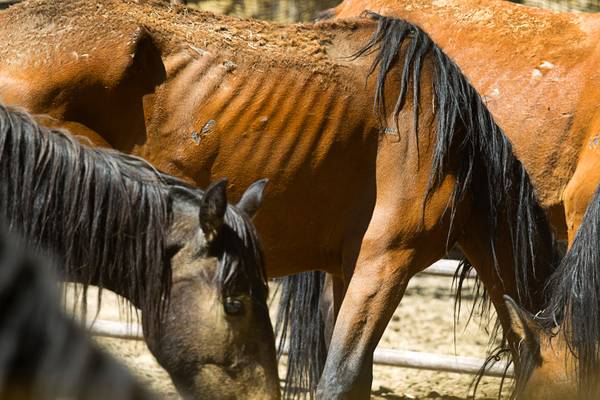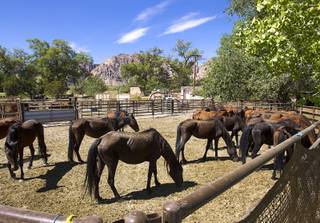The beige mare’s skin stretched tightly over her ribs as she grazed at Oliver Ranch. It’s the temporary holding area for the wild horses the Bureau of Land Management rounded up at the end of August to save from the drought that’s parching the American West.
Given the horse’s emaciated frame — protruding bones and no visible fat on her neck or around her tail — BLM officials assessed her condition as a one of nine, the most dire. Healthy horses are a five or six, said Karla Norris, assistant district manager for the BLM’s Southern Nevada District Office.
“It’s just sad,” Norris said, peering into a pen housing multiple sick horses. “That’s no way to live.”
Starting in late August, the BLM rounded up 201 wild horses from the Cold Creek range northwest of Las Vegas to keep them from starving. Twenty-eight were euthanized.
The horses were kept near Red Rock National Conservation Area before being taken to a private facility in Utah, where they will be rehabilitated for adoption or life on off-range pastures.
A 1971 law requires the BLM to protect wild horses as “living symbols of the historic and pioneer spirit of the West.” But the symbolism cuts both ways. The situation of today’s wild horses mirrors that of many people in the modern West: clinging to a frontier mentality but dependent on the federal government to provide resources — water, most obviously.
“They’ve lost the ability to forage for food,” Norris said. “They are not wild horses anymore.”
Well-meaning people feed the horses illegally — apples, peanut butter-and-jelly sandwiches, gummy bears, Cheetos — even going so far as to drop off bales of hay. Because of the drought, the horses’ grazing lands have been stripped of vegetation, forcing them to eat the bark off Joshua trees.
Like city pigeons cooing for bread crumbs, the horses have come to expect sustenance from humans, a dependency the BLM used in its favor. The bureau put out food and gathered the horses in days, more quickly than originally expected.
“These (horses) are so acclimated to people that when we put out hay and water, it was like putting out a ‘free buffet’ sign,” Norris said.
Some wild horse advocates, including Darcy Grizzle, who has documented and photographed the Cold Creek herd for six years, support the roundup. Grizzle said that although it was difficult to watch, the move was necessary.
“They were going to die,” she said.
Other disagree. Arlene Gawne, president of the Spring Mountain Alliance, argues that only half of the horses should have been rounded up. The younger, healthier ones could have found new territory, she said.
The Spring Mountain Alliance has advocated for birth control to keep the herd’s population in line, but the BLM has not adopted the idea.
And the roundup isn’t finished. BLM officials announced this month they had identified more horses in Cold Creek that were in poor condition. It’s unknown how long the second roundup will continue.
Nevada’s wild horses now are a symbol of what the natural world has become: irrevocably transformed by humans.
“Please don’t feed them,” Grizzle said. “Let them be wild.”
For the horses in Cold Creek, it’s likely too late.



Join the Discussion:
Check this out for a full explanation of our conversion to the LiveFyre commenting system and instructions on how to sign up for an account.
Full comments policy